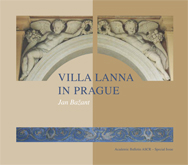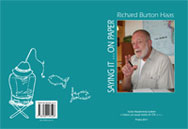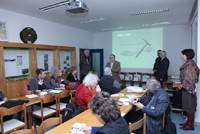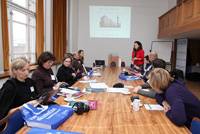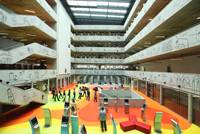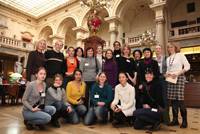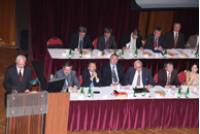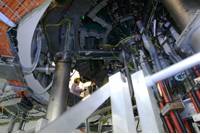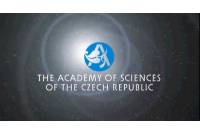
Academic bulletin 09/1999
Resume
Portraits from the Archives: Otakar Matoušek
The portrait of this month is devoted to the 100th anniversary of the birth of teacher and historian of science Otakar Matoušek. Dr. Matoušek was a member of astronomical society and was known for his activities in popularization of science in the journal Cosmos
Portraits from the Archives: Otakar Matoušek
The portrait of this month is devoted to the 100th anniversary of the birth of teacher and historian of science Otakar Matoušek. Dr. Matoušek was a member of astronomical society and was known for his activities in popularization of science in the journal Cosmos and in public radio broadcasts. He worked at the Czechoslovak Academy, his field being history of medicine and natural sciences. He focused his attention on the personality of Jan Evangelista Purkyně and other doctors of medicine and scientists of his era. His publications, articles and lectures became popular not only in Bohemia, but also abroad, and, consequently, he obtained several invitations from prestigious foreign universities as "visiting professor". Otakar Matoušek died in Sweden, on January 4th, 1994, almost 95 years old.
Science - Research - Society
Transgenic Plants
Transgenic plants are plants modified by means of genetic engineering, during the process of adding genes of other non-related organisms into their genetic base. It is believed that their use can solve problems of the increasing human population, which of course requires an increasing potential of agricultural production. It is a bit of a paradox that the currently grown transgenic species (about 50 types) are being considered as the most controversial application among the results of contemporaneous scientific research.
Comparison and Evaluation of the Scientific Journals Published by ASCR
Eurodyn`99
The 4th international conference of the European Association for Structural Dynamics ("Eurodyn '99") was held in Prague, on June 7th - 10th, with 231 participants from 37 countries in attendance. "Eurodyn' 2002" is planned to take place in Munich.
A Total Eclipse of the Sun Will Occur on August 11th
Need of a Scientific Base in Providing Ecological Education
ECDL - European Computer Driving License
The project ECDL - European "certification of computer literacy"- was introduced to the Czech public in Národní dům, on June 2nd, 1999. The idea originated in Western Europe as a reaction to problems related to the rapid development of the information technologies. This in turn created a demand for determination of the minimum knowledge necessary for employees of state and commercial institutions to use these technologies. International certification ECDL (advised and used in the countries of EU as a standard for computer intelligence) is now available in the Czech Republic.
Method SIFT - the Analysis of Respiration
Professor David Smith from Keelo University, England, and Doctor Patrik Španěl from the J. Heyrovsky Institute of Physical Chemistry, ASCR, recently developed a new method for measurement of concentrations of trace elements in gases of human breath, indicating the occurrence of some diseases.
Young People Are Developing Their Rhetorical Abilities
Seeking Lost Elegance
Interview
The Brdička's Lecture, Professor Schaefer and God
Professor Henry F. Schaefer III from the University of Georgia, the third most quoted chemist in the world, who was nominated five times for the Nobel prize, delivered an address entitled "The Third Age of Quantum" (the ninth in the series of Brdička's Lectures) at the J. Heyrovsky Institute of Physical Chemistry of ASCR, on June 16th. Our brief interview is focused on three other lectures Professor Schaefer has given concerning the relation between science and religion.
Introducing the Institutes
The Institute of Hydrobiology of the ASCR
Portraits
Astronomer of the Multimedia Universe
This month's interview was obtained from Doctor Zdeněk Pokorný, scientist and Deputy Director of the Mikuláš Koperník Observatory and Planetarium in Brno, who was awarded The Academy of Sciences Award for his scientific publications and projects popularizing astronomy, astrophysics, and theoretical physics, especially for his work with new electronic media, such as CD-ROM Astro 2001.
Events
The Academy Awards Ceremony
Awards of Josef Hlávka in Lužany
Czech Science Obtained a Unique Device
A new laboratory was opened in the J. Heyrovsky Institute of Physical Chemistry of ASCR, on May 27th. The laboratory is equipped with a new, highly effective electron spectrometer ESCA 310 produced by the Gammadata Scienta AB Company in Uppsala, Sweden. ESCA is the most perfect device of its kind, its installation and usage in the Czech Republic paralleling the latest advances in this field of research in the most developed countries.
Polemic
Statement of the Chief Manager of Czech Public TV, Jakub Puchalský
How to Choose a Director
Topical Supplement
Foundation Giorgio Cini Does Not Stand Idle: Baroque in Italy, Baroque in Bohemia
The foundation Giorgio Cini from Venice, the Academy of Sciences of the Czech Republic, the Italian Institute of Culture in Prague and the Charles University of Prague organized the second conference on the baroque epoch, the first having been held in Venice three years ago. The assembled community of experts in art history, history and literature opened discussion on rarely known information about this important period in the history of our civilization. Many new facts and opinions inspiring both Czech and Italian groups of scientists emerged and will form the basis for further research.


 Česky
Česky



